Notes: On 1st July 1906 a new halt was opened between Coombe Lane and Woodside in an attempt to attract more passengers to the Selsdon Line. The station was originally going to be called Addiscombe Park but by the time it opened this had been changed to Bingham Road Halt. The halt had two timber platforms made our old sleepers and no buildings but it was short lived. closing on 15th March 1915 as an economy measure during WW1 and did not reopen after the war.
 |
When the Selsdon line was electrified in 1935 because of the development in the area Bingham Road Halt was rebuilt as a station with brick entrances on Bingham Road with covered stairways on either side of the bridge leading up to the platforms which consisted of pre-fabricated concrete panels supported on concrete piles driven into the embankment and |
sheltered by glazed wood and steel canopies. There were still no additional buildings on the platforms and there were no freight facilities at the station.
| Track lifting started in the summer of 1984 and by the end of the year Bingham Road Station had been largely demolished. Construction of the Croydon Tramlink started in January 1997. At Bingham
Road this involved the removal of the embankment and the bridges
over Bingham Road and Addiscombe Road. As originally planned the new tram station would have retained
the name Bingham Road. The track |
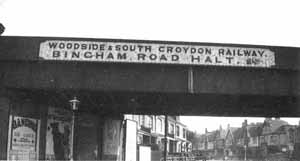 |
was re-laid
at street level and a new tram station was built on the north
side of Bingham Road, the original station having been on
the south side. This station was named Addiscombe replacing
the British Rail's Addiscombe Station which closed on 2.6.1997.
Bingham Road Station used in the Tony Hancock film 'The Rebel'
where he jumps in the train and gets out the other side and into
the London bound train.
BRIEF HISTORY OF THE ELMERS END TO SELSDON LINE
The Woodside & South Croydon Railway was authorised in 1880 to build a 2 mile 28 chain link from the South Eastern Railway's Mid Kent line at Woodside to a junction with the the Croydon & Oxted Joint (LBSCR & SER) line which opened on the 10th March 1884. The Woodside & South Croydon Railway opened on 19th
August 1885 with
an intermediate station at Coombe Lane and a junction station with the Oxted line at Selsdon Road. The main engineering feature on the line were three contiguous tunnels under the Addington Hills, Woodside (266 yards), Park Hill (122 yards) and Coombe Lane (157 yards). Rolling stock was supplied
by the South Eastern Railway who ran the service until the London
Brighton & South Coast Railway took over at the beginning
of 1887.
 |
The line had a chequered career from the offset; the first proposal
to close came in 1895. With increasing competition from trams
and busses in the early 1900's Kitson
Railmotors were introduced to try and improve passenger numbers. At the same time two new halts
were opened, Spencer Road Halt between Selsdon Road and Coombe
Lane and Bingham Road Halt |
between Coombe Lane and Woodside. Both were
very basic built of old sleepers with no buildings. Bingham
Road was sited close to the tram terminus in Lower Addiscombe
Road and was well used.
Although passenger numbers improved it was not enough and with
losses running at over £2000 a year the passenger service
was withdrawn as a wartime economy measure in 1915 when the Railmotor service was withdrawn. Coombe Lane
and Selsdon Road remained open for some through trains until 1916
but the new halts were closed.
For a while the line was used to store surplus goods wagons but
after four years a daily goods service calling at Woodside and
Selsdon Road was introduced. In 1927 the track was re-laid which
brought speculation about the restoration of the passengers service,
this didn't happen but the line became part of a new through route
to the south coast and into Kent for excursions and special services.
Oxted line as far as Sanderstead to allow trains to reverse. Coombe Lane was rebuilt and was rebuilt and renamed Coombe
Road and Bingham Road Halt was rebuilt as a station. Initially
it was going to be renamed Ashburton but on opening it retained
its original name of Bingham Road. Selsdon Road was renamed Selsdon
while Spencer Road Halt was not reinstated and the remains of
the station were cleared away. The new electric service started
on 30th September 1935.
 |
The early enthusiasm was however short lived with disappointing
passenger numbers bring a reduction of the service during WW2
with still further reductions after the war when off peak trains
terminated at Elmers End. With no improvement during the 1950's
closure was announced for 4th March 1963. A local pressure group
was formed to fight the closure claiming there was no alternative
and after several public meetings the Ministry of Transport rejected
the closure plans because of the hardship it would cause to the
650 daily passengers using the line. With no improvements the
Saturday service was withdrawn in January 1967 and in 1976 all
through trains to London were withdrawn reducing the line to a
shuttle service between Sanderstead and Elmers End, seven years
later the line finally closed on 13th May 1983. The track was
lifted during the summer of 1984 and by the autumn of that year
Bingham Road and |
Coombe Road stations had been demolished. A short
section of track between Selsdon and the footbridge at Spencer
Road was retained to serve the Selsdon Oil Siding. This finally closed in 1993 and although heavily overgrown the track
is still there as is the down platform at Selsdon.
| In 1986 a study of Greater London transport was undertaken by
London Transport and British Rail, one of its proposals was the
reintroduction of trams in the Croydon area to ease traffic congestion
and to provide a service into New Addington which was poorly served
by pubic transport. In 1990 Croydon Council and London Transport
began working together to |
 |
promote the Tramlink project which received
considerable public support.
In 1986 a study of Greater London transport was undertaken by
London Transport and British Rail, one of its proposals was the
reintroduction of trams in the Croydon area to ease traffic congestion
and to provide a service into New Addington which was poorly served
by pubic transport. In 1990 Croydon Council and London Transport
began working together to promote the Tramlink project which received
considerable public support.
| In November 1991 the Croydon Tramlink Bill was submitted to Parliament
and received Royal Assent on 21 July 1994, allowing London Regional
Transport to authorise the construction of Tramlink. Three routes
were to be built, Croydon - Beckenham Junction, Croydon - new
Addington and Wimbledon - Elmers End. As the lines from New Addington,
Beckenham and Elmers End converged on Croydon (click here for map) they would utilise almost the entire length of the former
Elmers End to Selsdon railway line with the three lines joining
at a new junction at |
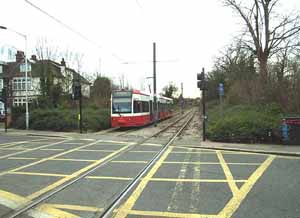 The site of Bingham Road Station in January
2005
The site of Bingham Road Station in January
2005
Photo by Chris Fletcher |
Sandilands from where they would run into
central Croydon. The first Tramlink route to New Addington opened on 10th June
2000 with the line to Beckenham through Addiscombe following
on 23rd May.
For a full history and photographs of the Woodside and South
Croydon Railway see the Transport
of Delight web site. Click here
for a photo gallery.
See also Unofficial
Croydon Tramlink & Disused Railways and Eighties Rail Heaven web sites. Tickets from Michael Stewart & Brian Halford
Further reading: Croydon's Railways by M W G Skinner - Kingfisher
1985 ISBN 0 046184 14 3
and Croydon Light Rail (Tramlink) a report considered by the Highways
& Transportation Planning, Resources, Fiancee & Policy
Committees at their meetings on 27.2.1991 & 15.5.1991
To see other stations on the Elmers End to Selsdon Line click on station name: Elmers End, Woodside, Coombe Road, Spencer Road Halt & Selsdon - see also Park Hill Tunnel |

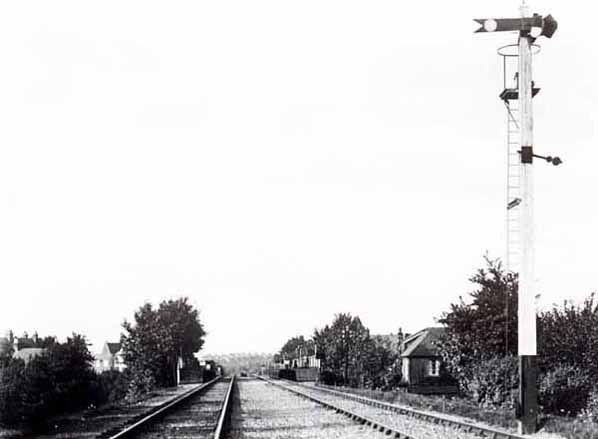

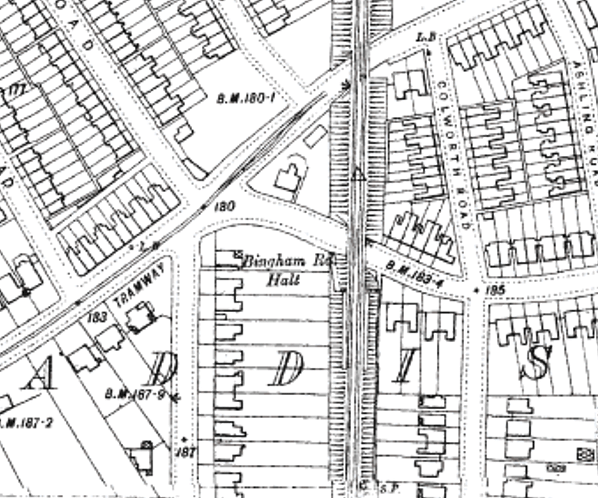
old5.jpg)
road46.jpg)
road45.jpg)
road28.jpg)
road35.jpg)
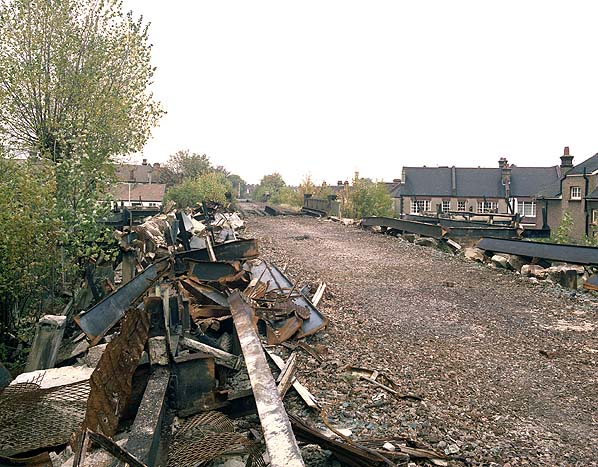

 Home Page
Home Page 









